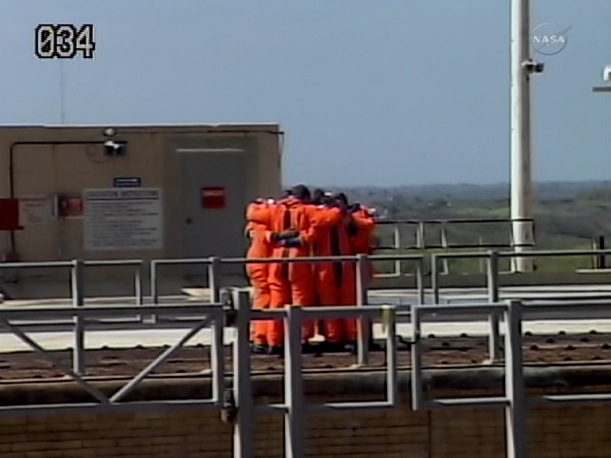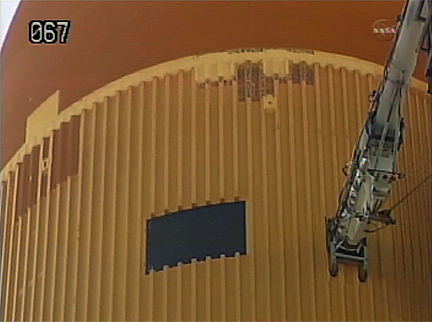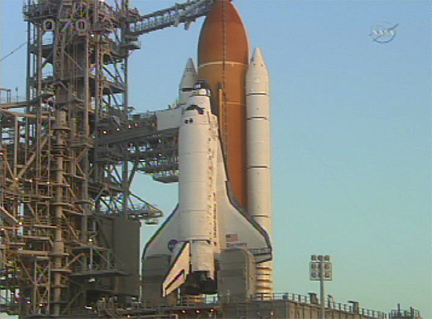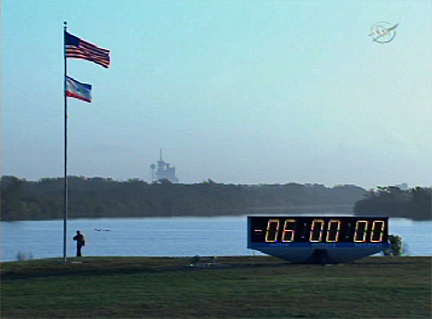Realtime coverage of STS-133 launch countdown (UPDATED)
By WILLIAM HARWOOD
CBS News
02:00 p.m. EST Update: Crew boards shuttle Discovery
The shuttle Discovery's crew -- commander Steven Lindsey, pilot Eric Boe, Nicole Stott, Michael Barratt and spacewalkers Stephen Bowen and Alvin Drew -- began strapping in shortly after 1:30 p.m. EST. There are no technical problems of any significance and forecasters are continuing to predict near ideal conditions for a launch attempt at 4:50:27 p.m.
10:55 a.m. EST Update: Shuttle fueling complete; countdown proceeding smoothly
The shuttle Discovery's external tank has been loaded with more than a half-million gallons of liquid oxygen and hydrogen rocket fuel. The fueling procedure began at 7:25 a.m. EST (GMT-5) and was declared complete at 10:19 a.m.
The tank is now in "stable replenish" mode and NASA's final inspection team is carrying out a launch pad walk down to look for any signs of debris or other problems that could cause trouble. There are no known issues and forecasters are continuing to predict a 90 percent chance of acceptable weather.
9:40 a.m. EST Update: Hydrogen vent line working normally
Fueling of the shuttle Discovery is proceeding smoothly at pad 39A. There are no technical problems of any significance and engineers say a 7-inch gaseous hydrogen vent line that leaked Nov. 5, triggering Discovery's most recent launch delay, appears to be working normally today.
"We're feeling very, very confident now that we have a good seal on the hydrogen vent arm and so that should not give us any more problems the rest of the day," said Launch Director Mike Leinbach. "So we should be good to go from that perspective."
The vent line is needed because some of the liquid hydrogen inside the tank turns into a gas that must be carried away to maintain the proper internal pressure. The vent line attaches to the side of the tank at a ground umbilical carrier plate, or GUCP, that features a large quick-disconnect fitting.
During a launch attempt Nov. 5, a significant leak was observed as the tank filled and the vent line was exposed to ultra low temperatures. Similar leaks delayed two earlier shuttle missions.
Extensive troubleshooting showed leaks can occur because of slight alignment errors in the quick-disconnect hardware, errors that only cause a problem when the metal is exposed to the low temperatures experienced during fueling. Engineers revised their installation procedures to ensure a proper alignment and the system worked normally during a fueling test in December.
While the vent line leak last November triggered Discovery's most recent actual launch delay, the flight has been on hold since then because of unrelated cracks in the shuttle's external tank. The cracks were repaired and the tank was modified to prevent any additional stress-relief fractures.
07:50 a.m. EST Update: Shuttle fueling begins; weather 90 percent 'go'
Hoping to put a three-and-a-half-month launch delay behind them, engineers began pumping a half-million gallons of liquid oxygen and hydrogen rocket fuel into the shuttle Discovery's external tank early Thursday to set the stage for blastoff on an 11-day space station resupply mission, the orbiter's 39th and final flight. Liftoff is targeted for 4:50:27 p.m. EST (GMT-5).
Forecasters are predicting a 90 percent chance of acceptable weather, with scattered clouds at 3,000 and 25,000 feet and winds at 14 knots with gusts to 20. The forecast calls for a 70 percent chance of good weather Friday as a cold front moves through the area, dropping to 60 percent "go" on Saturday. The launch window extends through March 6.
Working by remote control, engineers began the three-hour fueling procedure on time at 7:25 a.m., pumping liquid hydrogen and oxygen through transfer lines leading to the shuttle's aft engine compartment and from there, into the huge external tank.
If all goes well, the tank will be in "stable replenish mode" by around 10:25 a.m. At that point, attention will shift to the Johnson Space Center in Houston where flight controllers are monitoring an unmanned European cargo ship in the final stages of an automated approach to the International Space Station.
The Automated Transfer Vehicle 2, loaded with more than seven tons of supplies and equipment, was launched from Kourou, French Guiana, last week by an Ariane 5 rocket. Docking at the station's aft port is expected at 10:46 a.m. If there are any major problems, Discovery's launch could be delayed, but the craft has operated flawlessly since launch and flight controllers expect a trouble-free linkup.
Back at the Kennedy Space Center, commander Steven Lindsey, pilot Eric Boe, Nicole Stott, Michael Barratt and spacewalkers Stephen Bowen and Alvin Drew will begin strapping in around 1:30 p.m. to await liftoff on the 133rd shuttle mission.
"The launch team is not working any technical issues that would prevent us from launching on time this afternoon at 4:50 p.m. Eastern," said NASA commentator Allard Beutel.
The primary goals of Discovery's mission are to deliver a new cargo module loaded with supplies and equipment to the International Space Station along with an external storage platform and a spare set of cooling system radiators.
Launch originally was scheduled for Nov. 1, but the flight was delayed to Nov. 5 by technical problems, bad weather and then because of a leak in a gaseous hydrogen vent line attached to the side of the shuttle's external tank. When the tank was being drained in the wake of the launch scrub, engineers discovered cracks in the tank's foam insulation and launch was put on indefinite hold.
The gaseous hydrogen leak was blamed on subtle alignment issues with a quick-disconnect fitting that connects the vent line to the tank. Engineers were confident the vent line hardware, known as a ground umbilical carrier plate, or GUCP, would work normally this time around, but it typically takes an hour or more for the hydrogen tank to reach a level where a vent line leak might show up.
Fixing the quick-disconnect problem was relatively straight forward. But the foam cracks were symptoms of a more serious issue. When the damaged foam was cut away, engineers discovered fractures in underlying rib-like stringers used in the "intertank" compartment that separates the tank's liquid oxygen and hydrogen tanks.
The cracks occurred near the tops of several stringers where the vertical ribs meet a massive flange that supports the upper liquid oxygen tank.
An exhaustive engineering analysis blamed the cracks on the use of a more brittle than expected aluminum-lithium alloy, manufacturing issues and the effects of ultra low-temperature liquid oxygen at minus 297 degrees Fahrenheit. As the oxygen tank is loaded, the hardware contracts by several inches, pulling the tops of the stringers inward. They are designed for that, but the alloy used in Discovery's tank was more brittle than usual and cracks developed.
The fractures were repaired by splicing in fresh stringer sections, along with doublers to provide additional strength. To beef up the remaining stringers, so-called "radius block" doublers were riveted into place to make the ribs less susceptible to stress-relief fractures. In all, 105 of the 108 intertank stringers were modified. The goal was to ensure the tank's structural integrity and to prevent any cracks that could result in foam losses during ascent that could damage the shuttle's fragile heat shield.
Engineers were confident the modified tank is up to the rigors of fueling and launch. But just to be sure, cameras will be focused on the intertank during the remainder of the countdown and a final inspection team sent to the pad after fueling will be on the lookout for any foam cracks that might be indicative of underlying problems.
"The tank will get a 100 percent inspection and when the guys come back to the firing room and report out to us, the tank will be what it is," said Launch Director Michael Leinbach. "It's either going to be ready to go or there's going to be some issues. We don't expect any issues at all, but if there are, we're going to find them and we'll talk about them. ... I assure you, this tank will get a complete inspection, both in the firing room and by the final inspection team at the pad, before we commit her to flight."
Here is a timeline of the remaining countdown milestones (in EDT and launch-minus time; best viewed with fixed-width font):
CBS News
02:00 p.m. EST Update: Crew boards shuttle Discovery
The shuttle Discovery's crew -- commander Steven Lindsey, pilot Eric Boe, Nicole Stott, Michael Barratt and spacewalkers Stephen Bowen and Alvin Drew -- began strapping in shortly after 1:30 p.m. EST. There are no technical problems of any significance and forecasters are continuing to predict near ideal conditions for a launch attempt at 4:50:27 p.m.
 |
| The shuttle Discovery's crew shares a private moment at pad 39A before strapping in for launch. (Photo: NASA TV) |
10:55 a.m. EST Update: Shuttle fueling complete; countdown proceeding smoothly
The shuttle Discovery's external tank has been loaded with more than a half-million gallons of liquid oxygen and hydrogen rocket fuel. The fueling procedure began at 7:25 a.m. EST (GMT-5) and was declared complete at 10:19 a.m.
The tank is now in "stable replenish" mode and NASA's final inspection team is carrying out a launch pad walk down to look for any signs of debris or other problems that could cause trouble. There are no known issues and forecasters are continuing to predict a 90 percent chance of acceptable weather.
9:40 a.m. EST Update: Hydrogen vent line working normally
Fueling of the shuttle Discovery is proceeding smoothly at pad 39A. There are no technical problems of any significance and engineers say a 7-inch gaseous hydrogen vent line that leaked Nov. 5, triggering Discovery's most recent launch delay, appears to be working normally today.
 |
| The 7-inch gaseous hydrogen vent line attached to the side of the shuttle Discovery's external tank. (Photo: NASA TV) |
"We're feeling very, very confident now that we have a good seal on the hydrogen vent arm and so that should not give us any more problems the rest of the day," said Launch Director Mike Leinbach. "So we should be good to go from that perspective."
The vent line is needed because some of the liquid hydrogen inside the tank turns into a gas that must be carried away to maintain the proper internal pressure. The vent line attaches to the side of the tank at a ground umbilical carrier plate, or GUCP, that features a large quick-disconnect fitting.
During a launch attempt Nov. 5, a significant leak was observed as the tank filled and the vent line was exposed to ultra low temperatures. Similar leaks delayed two earlier shuttle missions.
Extensive troubleshooting showed leaks can occur because of slight alignment errors in the quick-disconnect hardware, errors that only cause a problem when the metal is exposed to the low temperatures experienced during fueling. Engineers revised their installation procedures to ensure a proper alignment and the system worked normally during a fueling test in December.
While the vent line leak last November triggered Discovery's most recent actual launch delay, the flight has been on hold since then because of unrelated cracks in the shuttle's external tank. The cracks were repaired and the tank was modified to prevent any additional stress-relief fractures.
07:50 a.m. EST Update: Shuttle fueling begins; weather 90 percent 'go'
Hoping to put a three-and-a-half-month launch delay behind them, engineers began pumping a half-million gallons of liquid oxygen and hydrogen rocket fuel into the shuttle Discovery's external tank early Thursday to set the stage for blastoff on an 11-day space station resupply mission, the orbiter's 39th and final flight. Liftoff is targeted for 4:50:27 p.m. EST (GMT-5).
 |
| The shuttle Discovery at pad 39A early Thursday. (Photo: NASA TV) |
Working by remote control, engineers began the three-hour fueling procedure on time at 7:25 a.m., pumping liquid hydrogen and oxygen through transfer lines leading to the shuttle's aft engine compartment and from there, into the huge external tank.
If all goes well, the tank will be in "stable replenish mode" by around 10:25 a.m. At that point, attention will shift to the Johnson Space Center in Houston where flight controllers are monitoring an unmanned European cargo ship in the final stages of an automated approach to the International Space Station.
The Automated Transfer Vehicle 2, loaded with more than seven tons of supplies and equipment, was launched from Kourou, French Guiana, last week by an Ariane 5 rocket. Docking at the station's aft port is expected at 10:46 a.m. If there are any major problems, Discovery's launch could be delayed, but the craft has operated flawlessly since launch and flight controllers expect a trouble-free linkup.
Back at the Kennedy Space Center, commander Steven Lindsey, pilot Eric Boe, Nicole Stott, Michael Barratt and spacewalkers Stephen Bowen and Alvin Drew will begin strapping in around 1:30 p.m. to await liftoff on the 133rd shuttle mission.
"The launch team is not working any technical issues that would prevent us from launching on time this afternoon at 4:50 p.m. Eastern," said NASA commentator Allard Beutel.
The primary goals of Discovery's mission are to deliver a new cargo module loaded with supplies and equipment to the International Space Station along with an external storage platform and a spare set of cooling system radiators.
Launch originally was scheduled for Nov. 1, but the flight was delayed to Nov. 5 by technical problems, bad weather and then because of a leak in a gaseous hydrogen vent line attached to the side of the shuttle's external tank. When the tank was being drained in the wake of the launch scrub, engineers discovered cracks in the tank's foam insulation and launch was put on indefinite hold.
The gaseous hydrogen leak was blamed on subtle alignment issues with a quick-disconnect fitting that connects the vent line to the tank. Engineers were confident the vent line hardware, known as a ground umbilical carrier plate, or GUCP, would work normally this time around, but it typically takes an hour or more for the hydrogen tank to reach a level where a vent line leak might show up.
 |
| Launch pad 39A as viewed from the Kennedy Space Center press site. (Photo: NASA TV) |
The cracks occurred near the tops of several stringers where the vertical ribs meet a massive flange that supports the upper liquid oxygen tank.
An exhaustive engineering analysis blamed the cracks on the use of a more brittle than expected aluminum-lithium alloy, manufacturing issues and the effects of ultra low-temperature liquid oxygen at minus 297 degrees Fahrenheit. As the oxygen tank is loaded, the hardware contracts by several inches, pulling the tops of the stringers inward. They are designed for that, but the alloy used in Discovery's tank was more brittle than usual and cracks developed.
The fractures were repaired by splicing in fresh stringer sections, along with doublers to provide additional strength. To beef up the remaining stringers, so-called "radius block" doublers were riveted into place to make the ribs less susceptible to stress-relief fractures. In all, 105 of the 108 intertank stringers were modified. The goal was to ensure the tank's structural integrity and to prevent any cracks that could result in foam losses during ascent that could damage the shuttle's fragile heat shield.
Engineers were confident the modified tank is up to the rigors of fueling and launch. But just to be sure, cameras will be focused on the intertank during the remainder of the countdown and a final inspection team sent to the pad after fueling will be on the lookout for any foam cracks that might be indicative of underlying problems.
"The tank will get a 100 percent inspection and when the guys come back to the firing room and report out to us, the tank will be what it is," said Launch Director Michael Leinbach. "It's either going to be ready to go or there's going to be some issues. We don't expect any issues at all, but if there are, we're going to find them and we'll talk about them. ... I assure you, this tank will get a complete inspection, both in the firing room and by the final inspection team at the pad, before we commit her to flight."
Here is a timeline of the remaining countdown milestones (in EDT and launch-minus time; best viewed with fixed-width font):
EDT...........EVENT
10:25 AM......Begin 2-hour 30-minute built-in hold (T-minus 3 hours)
10:25 AM......Closeout crew to white room
10:25 AM......External tank in stable replenish mode
10:28 AM......Ascent flight control team on console
10:40 AM......Astronaut support personnel comm checks
10:46 AM......ATV 2 docks with the International Space Station
11:10 AM......Pre-ingress switch reconfig
12:20 PM......Final crew weather briefing
12:30 PM......Crew suit up begins
12:55 PM......Resume countdown (T-minus 3 hours)
01:00 PM......Crew departs O&C building
01:30 PM......Crew ingress
02:20 PM......Astronaut comm checks
02:45 PM......Hatch closure
03:15 PM......White room closeout
03:35 PM......Begin 10-minute built-in hold (T-minus 20m)
03:45 PM......NASA test director countdown briefing
03:45 PM......Resume countdown (T-minus 20m)
03:46 PM......Backup flight computer load OPS 1 software
03:50 PM......KSC area clear to launch
03:56 PM......Begin final built-in hold (T-minus 9m)
04:21 PM......NTD launch status verification
04:41:27 PM...Resume countdown (T-minus 9m)
04:42:57 PM...Orbiter access arm retraction
04:45:27 PM...Launch window opens
04:45:27 PM...Hydraulic power system (APU) start
04:45:32 PM...Terminate LO2 replenish
04:46:27 PM...Purge sequence 4 hydraulic test
04:46:27 PM...Inertial measurement units to inertial
04:46:32 PM...Aerosurface test profile
04:46:57 PM...Main engine steering test
04:47:32 PM...LO2 tank pressurization
04:47:52 PM...Fuel cells to internal reactants
04:47:57 PM...Clear caution-and-warning memory
04:48:27 PM...Crew closes visors
04:48:30 PM...LH2 tank pressurization
04:49:37 PM...Booster joint heater deactivation
04:49:56 PM...Shuttle flight computers take control of countdown
04:50:06 PM...Booster steering test
04:50:20 PM...Main engine start (T-6.6 seconds)
04:50:27 PM...Booster ignition (LAUNCH)